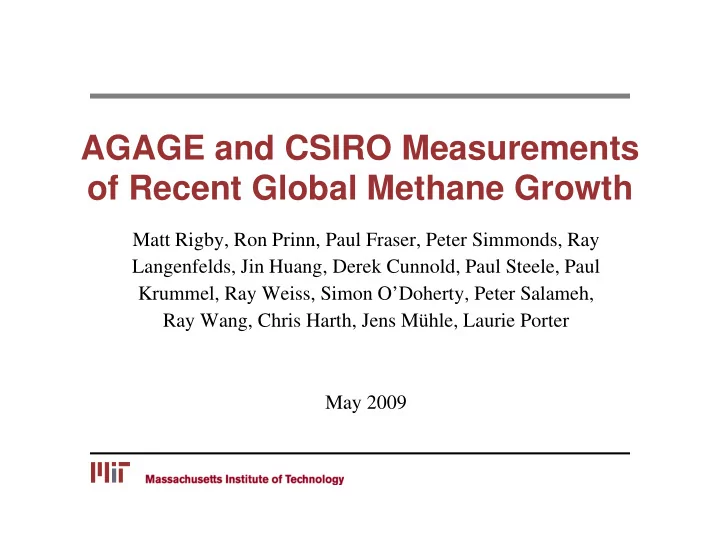

AGAGE and CSIRO Measurements of Recent Global Methane Growth Matt Rigby, Ron Prinn, Paul Fraser, Peter Simmonds, Ray Langenfelds, Jin Huang, Derek Cunnold, Paul Steele, Paul Krummel, Ray Weiss, Simon O’Doherty, Peter Salameh, Ray Wang, Chris Harth, Jens Mühle, Laurie Porter May 2009
AGAGE network • Advanced Global Atmospheric Gases Experiment • High frequency measurements of ozone depleting species and non-CO 2 GHGs agage.eas.gatech.edu Matt Rigby, June 2008 Page 2
CSIRO flask network • ~4 flasks per month analysed at CSIRO cdiac.ornl.gov Matt Rigby, May 2009 Page 3
Renewed CH 4 growth: AGAGE Matt Rigby, June 2008 Page 4 Rigby et al. 2008, Renewed Growth of Atmospheric Methane, GRL 35, L22805
Renewed CH 4 growth: CSIRO Matt Rigby, June 2008 Page 5 Rigby et al. 2008, Renewed Growth of Atmospheric Methane, GRL 35, L22805
Box model inversion OH OH OH OH 200hPa OH OH OH OH 500hPa OH OH OH OH 1000hPa 90N 30N 0N 30S 90S • Seasonally varying transport parameters from climatology + CFC inversion • OH from methyl chloroform inversion Matt Rigby, June 2008 Page 6
Constant OH: Hemispheric emissions • Inter-annually repeating OH Annual running means • ~ 40 Tg/yr increase from 2006 – 2007 (5-6%) • ~ 22 Tg /yr NH (5%), ~ 18 Tg/yr SH (10%) Matt Rigby, October 2008 Page 7
What changed in 2007? • Anomalous high temperatures over boreal wetlands • Wetland emission ~ temperature (and other factors)? / Melting permafrost?? Matt Rigby, June 2008 Page 8
What changed in 2007? • Biomass burning? CO increase? Matt Rigby, June 2008 Page 9
Influence of inter-annually varying meteorology • MOZART 4.5 + NCEP reanalysis + GFED v2 Matt Rigby, May 2009 Page 10
Sensitivity to Northern emissions • 10% emissions increase 30N – 90N (1 year pulse) 2007 2006 Matt Rigby, May 2009 Page 11
Sensitivity to tropical emissions • 10% emissions increase 30N – 30S (1 year pulse) Matt Rigby, May 2009 Page 12
OH decrease? • Methyl chloroform inversion: 4 ± 14% OH drop in 2007 • CH 4 increase: 20 Tg/yr global, 13 Tg/yr NH, 7 Tg/yr SH Matt Rigby, October 2008 Page 13
OH decrease? • Potential causes: CO � , (CH 4 � ), stratospheric O 3 � , H 2 O � , tropospheric O 3 � … Total column ozone (% change) Specific humidity (% change) NH NH SH SH NIMBUS-7/METEOR-3/EP/OMI data from climexp.knmi.nl NCEP reanalysis: weighted by OH concentration Matt Rigby, May 2009 Page 14
Conclusions • 2007 – present: renewed global methane growth following almost a decade of relatively stable levels • If no OH change, then substantial emissions increase required in both hemispheres • Changes in meteorology or biomass burning emissions do not appear to be responsible • A small (and NOT statistically significant) drop in OH is inferred, but the cause of such a drop is unclear Matt Rigby, June 2008 Page 15
Recommend
More recommend